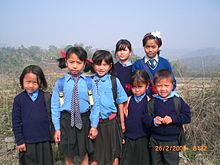Koireng people
| Total population | |
|---|---|
| 1056 (2001 census) | |
| Regions with significant populations | |
| Languages | |
| Koren, Manipuri, English | |
| Religion | |
| Christianity | |
| Related ethnic groups | |
| Aimol, Kharam, Kom, Purum, Ranglong, Biete, |
The Koireng People are one of the many indigenous peoples inhabiting Manipur in North-East India. They were classified under the Old Kuki Clans of the vastly spread Kuki-Chin group of peoples populating India, Burma and Bangladesh. They have a shared common ancestry, history, cultural traits, folklore and dialects with their kindred people.
Origin
The word 'Koireng', believed to be termed by the Meiteis is, is a corrupt version of the word, Kolren (Kol=east, Ren= people) or 'Koren'. Linguistically, Koireng is classified under the Tibeto-Burman of the Sino-Tibetan family of languages. Koirengs are generally short-statured, with straight black hair, dark brown eyes and brown skin. Koireng is a recognized scheduled tribe of India. They have linguistic and cultural affinities with some of their neighbouring kindred people such as the Aimol, the Thikhup, the Purum and the Kharam tribes of Manipur and the Ranglong, the Hrangkhol and the Biete tribes of NC Hills, Assam.

Culture and tradition
Koireng women use ornaments with Har (armlet), Yak-serr (armlet), Rikarui (a necklace of red beads). Koireng men of high social hierarchy decorate themselves with a fur of matured red goat's hair during important festivities.Important dress and customs are: (i) Puonthal (for males), Puonwom, Murkisen, thaite (turban) and (ii) Puonhem (for females)-ascribing higher status for being adorn with it. Puonsen, Saipikhup, Lung-um, Puonkok-hoi, Puon-lang, Korr-aam (the latter two clothes are waist belts). Musical instruments used are Khuong (drum), Roshem (a bagpiper-like musical instrument made of dried reeds and matured hollowed-out gourd), Sekhi (horn), Sum (gong) of various sizes, Serang-dar (a violin-like stringed instrument), etc. Household implements like spear, dao, guns, fishing baskets, carrying baskets, hoe, plough, yoke etc. were used.
Religion
The Koirengs have always believed in the existence of a supreme creator whom they refer to as Pathien. Old pagan rituals are no longer in practice. Today, leaving a few aged individuals, the entire Koireng populace have embraced Christianity.
Economy
The Koireng economy persists mainly on agriculture which they carry on by both wet method and shifting cultivation. Paddy, potato, ginger, yongcha (Parkia speciosa), etc., are some of the main products. Gathering economy and basket products for commercial goods form trade and market. Hunting in the form of sports is persistent during off-seasons in the villages of Thanglong, Utonglok and Sadu (Tungluong).
Koirengs: past and present
The Koirengs' last major colonial stronghold, as they entered Manipur, was the Thangjing hill range overlooking the pristine Loktak lake. Thangjing is derived from the Koren words, Thang = South, Ching=hill. Their historic dominance of this region was presumably a constant eyesore to the erstwhile kingdom of the Moirang clan. This proximity led to numerous aggressions. The Koirengs, already weakened after a major infernal disaster, were terribly defeated at the end. They ultimately underwent a diaspora in various parts of Manipur and North-East India. Today, the Koirengs (Korens) are sparsely scattered around the surrounding foothills of the Imphal valley of Manipur, India.
Tuiruong tiengmo chesik?
Tuivai tiengmo chesik?
(Old Koren Saying)
References
- Shakespear, J. (1909) 'The Kuki–Lushai Clans.' The Journal of the Royal Anthropological Institute of Great Britain and Ireland. Vol. 39 (Jul., 1909), pp. 371–385
- http://censusindia.gov.in/Tables_Published/SCST/ST%20Lists.pdf
- http://www.joshuaproject.net/peopctry.php
- Shakespear, J. (1922) Tangkhul Folk Tales and Notes on Some Festivals of the Hill Tribes South of Assam. 14 pp.
- McCulloch/ Major W., 'Account of the valley of Munnipore and of the Hill Tribes'. Selections from the Records of the Government of India, No. 27 (Calcutta) 1859
- Grierson, G. A. (Ed.) (1904b). Tibeto-Burman Family: Specimens of the Kuki-Chin and Burma Groups, # Volume III Part III of Linguistic Survey of India. Office of the Superintendent of Government Printing, Calcutta.
- Ethnic Races of Manipur
